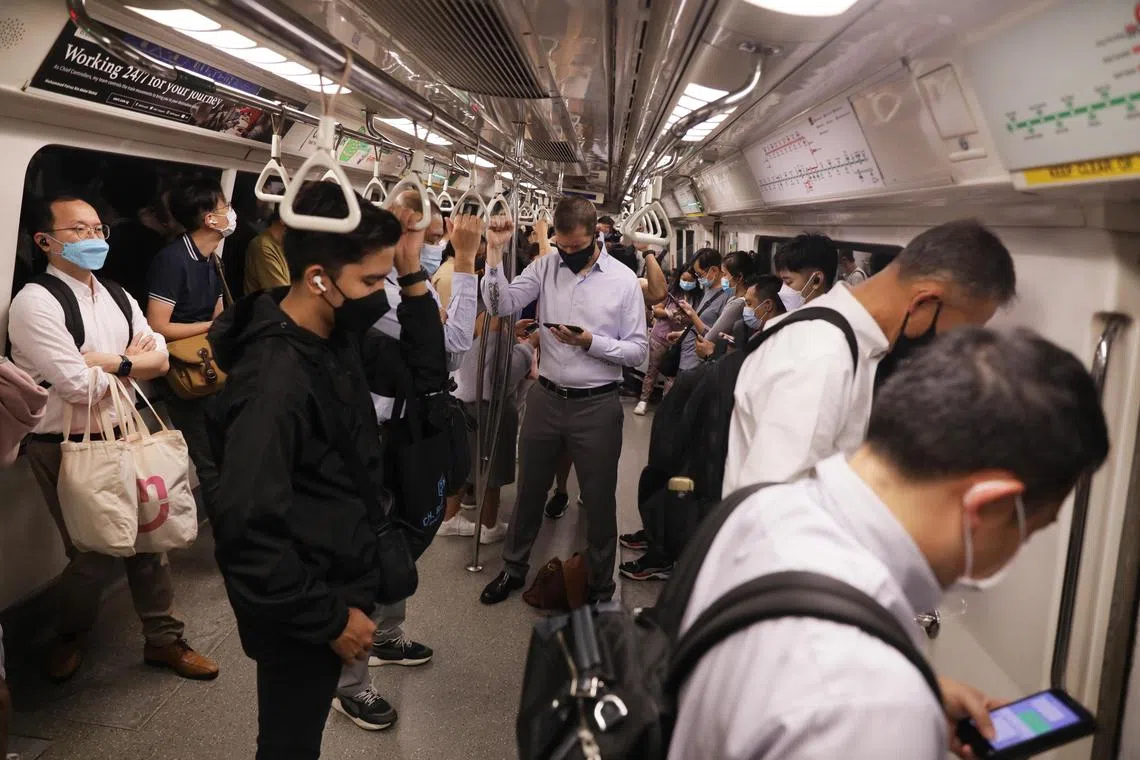Bus, train usage continues to recover in S’pore; 2022 ridership at 83% of pre-pandemic peak
Sign up now: Get ST's newsletters delivered to your inbox

Train ridership grew by 30 per cent in 2022.
ST FILE PHOTO
Follow topic:
SINGAPORE – Public transport ridership continued to recover in 2022 as more people returned to work and leisure activities after two years of Covid-19-related restrictions.
In 2022, there was an average of 6.39 million bus and train rides a day – 22 per cent higher than in 2021, but still the lowest annual average recorded in nine years, and 17 per cent below the peak in 2019.
According to figures released by the Land Transport Authority (LTA) on Wednesday, MRT and LRT rides led the growth with a 30 per cent increase in 2022 to 2.929 million rides per day, while buses chalked up a 15 per cent rise to 3.461 million rides. This contrasted with the previous year’s recovery, which was led by buses.
Observers reckoned this could be because of new MRT lines that have opened, such as stages 2 and 3 of the Thomson-East Coast Line.
Meanwhile, point-to-point transport usage also rose, but by smaller percentages. Private-hire car ridership rose by 8 per cent in 2022 to 347,000 a day, while taxi ridership crept up by 1 per cent to 235,000 rides. A surge in fares may have dampened demand for these services.
A reported driver shortage is seen as another factor hampering growth in this sector.
Senior Minister of State for Transport Amy Khor noted that the supply of point-to-point drivers has not recovered in tandem with demand.
There are now about 57,000 active drivers, fewer than the 59,000 in 2021, she said on Wednesday in a speech at a Chinese New Year lunch hosted by Grab.
Commenting on the latest ridership data, Singapore University of Social Sciences associate professor of economics Walter Theseira said: “In general, I expect ridership to continue to be slow to recover fully to pre-pandemic levels, given that most businesses have adopted greater flexibility in work, and some have even downsized their office space during the pandemic.
“I do not expect this will change significantly even as new MRT lines are deployed, because much of the ridership there will come from existing lines and bus services.
“Thus, looking forward, even as more Singaporeans are likely to take public transport due to better connectivity, the system will likely be more costly to operate on a per-passenger basis.”
Commuter Jimmy Chua is among the car owners here who use public transport regularly. The 39-year-old author said: “I am living near the Buangkok MRT station. It takes me only 20 minutes to get to town by MRT.”
But he noted that taxis are harder to come by these days. “Yesterday, I was trying to get a taxi via the (ComfortDelGro) app, and waited for 20 minutes. No taxi. I had to pay for a Grab private-hire vehicle, which cost more,” he said.
According to LTA statistics, Singapore’s taxi fleet stood at 14,084 as at end-December 2022 – less than half its peak size in 2014. Conversely, there were 46,477 private-hire cars at the end of 2022, up from just 1,609 in 2014.


